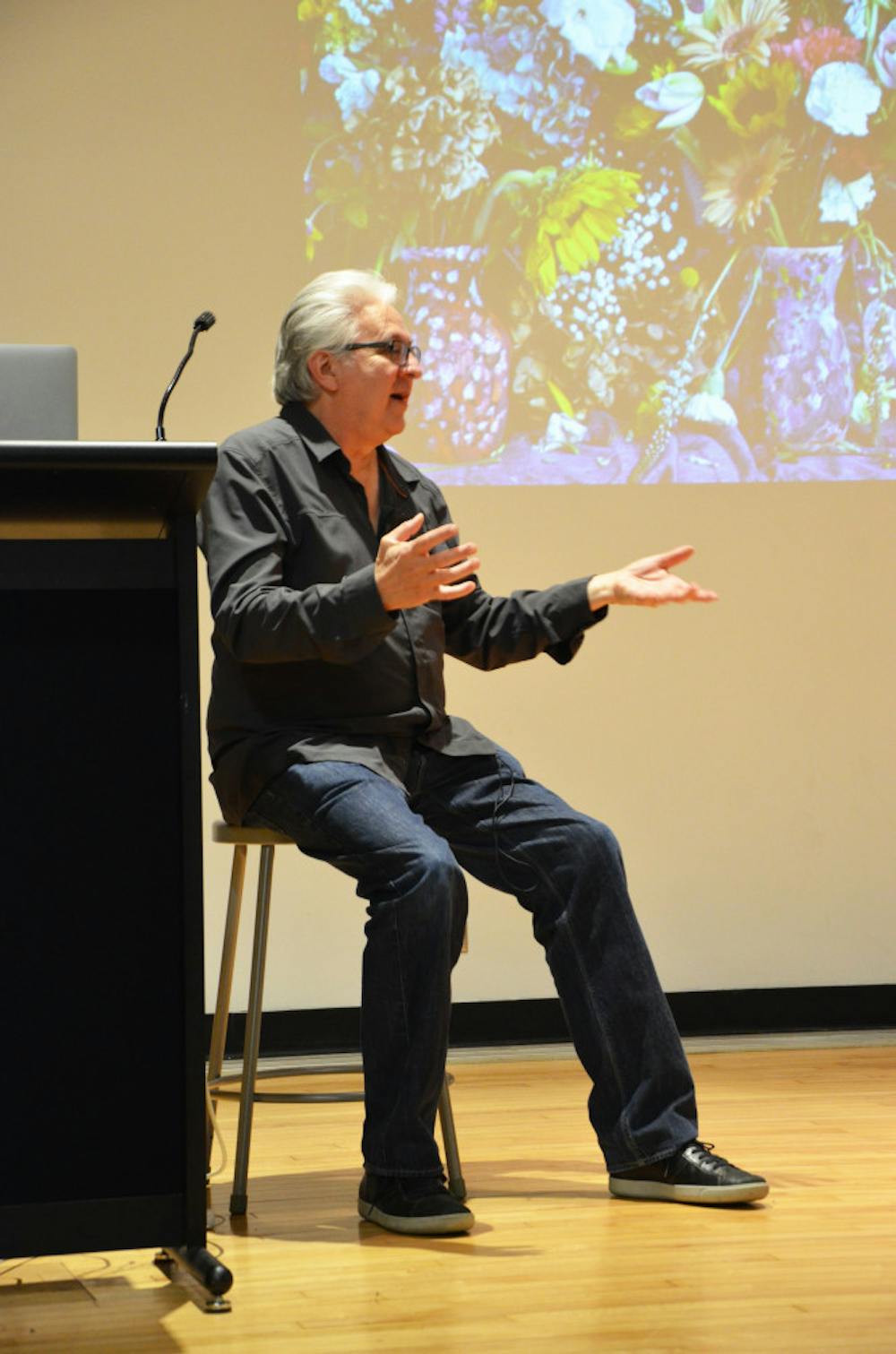Photographer Abelardo Morell, in a talk at the List Art Center Wednesday, introduced art as a way of experimenting with aesthetic techniques and looking at the world around us in new ways. Morell’s photography experiments with camera obscura and plays with novel perspectives.
Morell’s passion for his art showed through when he spoke about camera obscura, a technique he has experimented with extensively over the course of his career. In this natural optical phenomenon, a small hole is made in the wall of a dark room to project an upside-down image of the outside world onto the walls of the room. “Think about this,” Morell urged his audience. “This image is created by a hole, not created by Microsoft.” This phenomenon could have existed thousands of years ago through cracks in caves, he added, calling it a “powerful reminder of the physics of the world.”
With technological developments, Morell has been able to create camera obscura photographs that are colored, focused and right-side up. Digital technology also reduced the exposure time of his photographs from five hours to five minutes. This gave Morell a previously-impossible advantage in his photography to capture moments.
Morell hopes viewers of his work will discover “that the world is really interesting,” he said. “And if you take time out, there are all kinds of ways to think and be. I’m convinced that that’s important.”
In one piece, Morell used a tent camera to create the effect of camera obscura in outdoor settings. This technique involved a white tent that created the environment of a darkroom in order to make photographs that combined images of a landscape with the ground. Morell’s photographs in Big Bend National Park were a “hybrid of events,” he said. “The ground had something to say.” The process was enjoyable because it was a way to “revisit iconic pictures and make them my own,” Morell said.
Morell’s identity as an artist has been shaped by his role as a husband and father, he said. Early in his career, having a child made him think about photographs in a different way. He began taking photos at different angles, such as shots of children’s blocks from the ground up. Photographing from the angles of a child was liberating, Morell said.
From photographing the motifs of childhood, Morell progressed to water as a subject. It was a matter of “finding time to look at ordinary things,” he said, such as the movement of water out of a faucet. “Water can become all sorts of things. Water can become a lens,” he added.
In a series titled “Flowers for Lisa,” Morell experimented with multiple bouquets combined into one photograph. He let the flowers wilt and sometimes sprayed them with white, grey or black paint to create a “weird sense of continuity and death,” Morell said. Flowers represent themes of death, closeness, hope, sex and intimacy, Morell said, adding that dealing with flowers as an “emerging organism and an emerging consciousness” has been a part of his growth.
Morell photographs ordinary objects in such a way to make them extraordinary, displaying their uniqueness or beauty in a new way. For example, he has taken dozens of photographs of books. “Friends would call me up and ask, ‘What are you up to,’ and I would say, ‘I’m photographing books,’ and there would be silence,” Morell said. But in fact, “if you just start looking,” he added, “there are endless things that you can do.”
Morell’s talk was punctuated by his photographs displayed in a presentation: a book damaged by water, a page of “A Tale of Two Cities” lit from behind to view overlapping lines of text and one book inside another book that Morell dubbed “The Pregnant Book.” He should probably find the father one day, Morell joked.
Morell was the photographic illustrator of “Alice’s Adventures in Wonderland” by Dutton Children’s Books, and the novel itself became a subject of his illustrations. One photograph showed a cut-out of the White Rabbit ready to jump down the hole, which was drilled into the book itself.
Throughout all of Morell’s works is the theme of experimentation, finding or creating new perspectives. Working in art galleries, Morell moved statues in front of other works of art to capture multiple mediums and pieces of art in one shot. “Curators didn’t like this,” Morell recalled, but he loved using what he coined “real-life photoshop.”
Other projects of Morell’s include photographs of money, including one shot of 50 million dollars, and paper constructions. Morell strove “to reveal the underside of things, the beneathness of things” when photographing constructions he created from clippings of books and illustrations.
“Art isn’t about what I see; it’s all about what the camera sees,” Morell said. As photographers, “we have the task of sandwiching the 3D into the 2D,” he added. His work is about space and altering perspectives and angles.
“His process is definitely really interesting,” said Matt Barbarino, RISD ’18. “I’m digesting it right now.”
Another student said it was liberating to see an artist who moves across the boundaries of different artistic mediums. She described how there can be pressure as an artist to remain constrained within one medium, and listening to Morell helped dispel that confining notion for her.
Morell’s work has met great success and been collected and shown in over 70 galleries, institutions and museums both internationally and across the United States.
“I really appreciate how honest and down to earth he is,” said Ingrid Zippe ’18, a student in the visual art honors program. “He doesn’t blow up art in a way that is overly critical. I feel like he’s past the existential questioning stage. He’s just a human being.”





